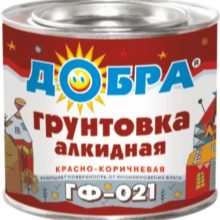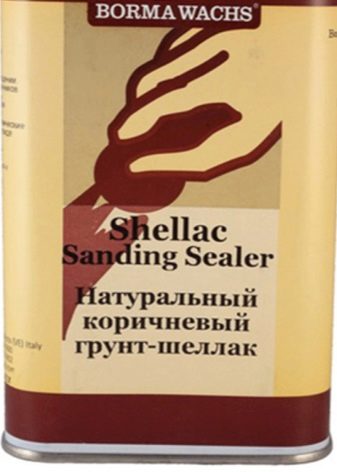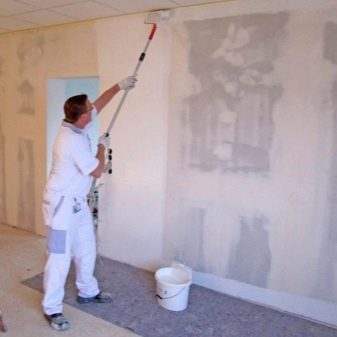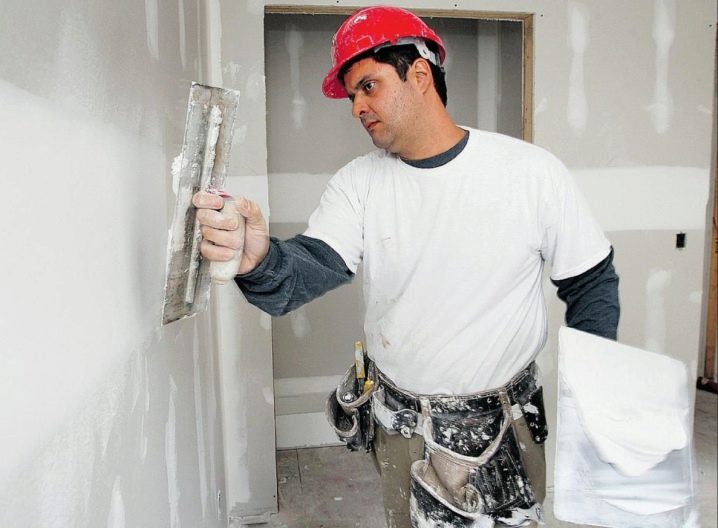Do I need to prime the walls before puttying?
Everyone who has begun to repair the house or apartment, is faced with the need for high-quality processing of walls and ceilings before covering them. Modern building mixtures for finishing work greatly simplify this process.
Regardless of how the surfaces will look after repairs (painting, wallpapering, fixing drywall), they must first be primed.
Why do I need to prime?
The primer solution is a liquid, usually colorless or white.
Transparent material is applied to the surface, prepared under the wallpaper. Opaque use for processing ceilings (in most cases).
When the putty is made without pre-priming, then after some time the walls or the ceiling will be showered.
In fact, have to redo everything.Plus, this will entail both a number of labor costs and financial expenses. To avoid such unpleasant moments, it is better to initially treat the surface and prepare them for finishing work.
The putty laid on top of the primer will stick on the walls or ceilings for many years.
In order to fasten among themselves all the materials with which the surfaces will be covered later, a primer is used. It acts as a connecting block between the base of the treated surface and the subsequent applied layers.
The quality characteristics of the primer are as follows:
- protects against the formation of mold and fungi on the walls;
- penetrates deep into cracks and fills them, creates a smooth and seamless surface of the wall before filling;
- levels the surface of any material (drywall, concrete and others);
- neutralizes the color of stains;
- surfaces to be treated may be brick, wood, concrete and plasterboard.
Types of primers
Today, the paint industry represents a choice of a wide range of mixtures for preparing surfaces for further coating.
The main ones are: alkyd, acrylic, polystyrene, phenol-based primers, adhesive, mineral, latex and others.
Alkyd is designed for processing wooden structures. Protects the tree from rotting and various insects. Fashionable direction in construction is the creation of houses from wood material. If in the future the surface will be coated with varnish, then it is necessary to prepare it by applying the primer.
Developed and implemented in the production and sale of primer using shellac.
It is a liquid mixture, firmly penetrating into the depths of the wood layer (smoothing the surface where there are knots) and making it completely resistant to moisture penetration. Protects against the formation of fungal deposits.
Acrylic primer is used for almost all types of surfaces. Very durable layer falls on the surface. Its peculiarity lies in the fact that it is possible to process metal structures as well as surfaces that absorb moisture slowly. Waterproof substrates are best treated with mixtures that are compatible with them. For the preparation of the wall under the wallpaper is well suited primer "Optimax".It will not only hide all surface defects, but also paint the wall white, which is important for thin wallpaper stickers.
Adhesive mix intends for rough surfaces. It is convenient to lay tiles on them. The primer incorporates quartz sand. Will be suitable for the bases on which decorative plaster will be put.
There are primers, such as glyptal perchlorovinyl. They are designed for application to cement, brick and wood. Used for outdoor use. Have very high toxicity.
Mixtures that include abrasive particles (quartz sand) are used to cover concrete, for example, "Betonokontakt". The bases from concrete are checked for durability. All irregularities and grooves are covered with cement, and after drying, the primer is used for surface treatment. It can be used before applying the topcoat. The adhesion of the wall will increase many times after treatment with such a composition.
For rooms with high humidity suitable primer with antibacterial components.
Polystyrene is usually applied to external surfaces, since it has a strong toxicity and is not used for work inside.
Phenol is applied to metal surfaces. To prevent the appearance of corrosion on metal surfaces using anti-corrosion compounds.
Universal and acrylic is used for drywall (HL and GVL). This is a material that absorbs moisture very well and requires a mandatory primer, especially in the areas of seams and seams. It is also necessary to carry out this stage of work before laying tiles.
Gypsum plasterboards (gypsum plasterboard) and gypsum-fiber (GVL) are a material containing a plaster base, pasted over with a flexible and smooth cardboard. These sheets produce wall cladding, fasten them to the ceilings, install various partitioning compositions indoors.
Knauf, being a manufacturer of drywall, has developed and introduced a primer for its processing into production. Primer "Knauf" is universal and has high quality indicators.
Plasterboard structures have become more installed in rooms with high humidity. This opportunity presented itself due to the fact that a new composition has appeared in the production of paints and primers. The surfaces processed by it do not lose their original characteristics and remain unchanged for many years.
Latex primers in their composition have the juice of a rubber tree, so they are referred to as natural components. The surface they treat becomes resistant to wear, water, and moisture. The composition is ideal for bases that crumble quickly (loose and old).
For outdoor work using mineral primer. They contain cement in their composition. Suitable for brick walls and those made of blocks.
Surface preparation
Some surfaces absorb moisture, while others do not, therefore the primer material for them will differ significantly.
To prepare the walls or the ceiling for further processing (painting, wallpapering, etc.) it is necessary to do the following:
- clean the surface from dust and dirt;
- scrape off old paint, if there is one;
- remove old wallpaper;
- wash and dry the walls;
- Seal cavities, cracks or chips with putty.
To clean the surface from dust can be a rag or with a vacuum cleaner. Paintwork material is cleaned with a spatula or paint scraper.
Wallpaper removed with a metal spatula and hot water, which should be wetted.After that, the old layer swells. Remove the wallpaper now does not make much work.
After removing the previous materials need to wash the walls. If there are surfaces on which the mold or fungus is concentrated, they are recommended to be treated with an antiseptic solution.
When the walls are cleaned, they are dried. The important point is that the drying process itself may take several days. It all depends on the surface on which the water has acted.
When the installation of plasterboard surfaces is completed, they are prepared for primer. The soil acts as an insulating material, increases the adhesive properties of the surface, penetrates deeply into the material, thereby subjecting it to polymerization (reinforcing). Surfaces can be screwed to the wall frame or fixed to the ceiling. The primer should be selected taking into account the surface area on which it will go. It is necessary to carry out preparatory measures for processing structures with high quality, so that later the finishing material (whether it be paint or wallpaper) evenly adjoins the main surface.
For the work you will need a container for the mixture itself, rubber gloves, a brush, a roller.It is possible to use the spray gun.
Application details
It is best to apply a primer in two layers: the first one is put between the wall under the plaster and the putty, and the second after the putty. Then the applied materials will not be able to peel off or crumble. The primer forms a protective layer, provides the ability for two layers inside to firmly join (interlock).
Everyone has the right to choose the soil, which he considers most suitable for the walls in his home. The variety of the range allows you to replace them with one another, it is only necessary to take into account the degree of humidity and air temperature in the room. The universal material that will treat any surface is an acrylic blend. Before applying to the wall, the composition is diluted with water.
A mixture of average penetration is applied to the surface under the wallpaper or under the painting of walls. Wallpapers should not be heavy.
For others use a mixture of deep penetration. Wallpaper in this case will be held for a long period of time.
The process does not require special skills.
Mixed primer is poured into the container. If the mixture is dry, it is diluted with water.If the solution is concentrated, then it is prepared taking into account the proportions indicated on the package.
Next, the walls are smeared with a brush evenly and thoroughly, especially in places where there have been cracks or damage. When the walls are old, for high-quality and reliable strengthening, it is necessary to apply the mixture in a thicker layer. If the base is porous, the primer is applied until the hollows are completely filled. Roller applied solution from the bottom up. Spread the solution over the entire area of the base.
Similarly to be treated and drywall. The entire surface is uniformly treated with the prepared (diluted with water) mixture. Brush handle joints and space for screws. The time of the subsequent drying of the solution depends on its type.
After the soil dries, a thin layer of finishing putty is applied to any surfaces. So align the walls. Reinforced tape is glued on the drywall at the joints. After drying it is necessary to make the final primer again.
Recommendations
For application to the concrete base subsequent coatings is best to use a quartz primer. Potent adhesive in its compositionwill help the layers of the surface to tightly connect with each other.
In order to make it convenient to carry out high-rise work on priming, you can adjust the roller on the pole. On sale are such auxiliary mechanisms.
Do not ask yourself about the advisability of applying a primer to walls, ceilings or other bases. Save money in this case is not worth it. The mixture will help prepare the surface for subsequent coatings. Less glue or paint will need to be applied to surfaces treated with the preparatory compound. The main thing - there will be no disappointments at the completion of the entire stage of repair work. The soil will not give the opportunity to peel off the wallpaper, peel off the paint, fall off the tile. You will save your strength and money.
Why priming the wall, see the video below.



























































